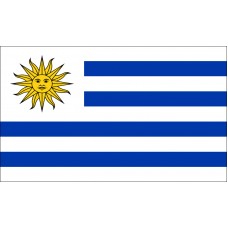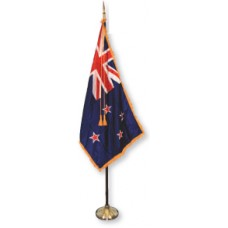Uruguay Flag
We carry authentic Uruguay Flags in both indoor and outdoor varieties. Our flags are proudly made in the United States from durable nylon and are printed with vibrant long-lasting inks. The Uruguay national flag is often displayed at embassies, outside of businesses associated with Uruguay, and at the homes of people who take great pride in their Uruguayan heritage.
Our indoor flags are finished with a pole hem and your choice of with or without golden fringe. Gold fringe is the traditional way to display an indoor flag, however, some people choose without fringe for a simple and clean look that is also less expensive. If you are looking for a complete indoor presentation set, our Build Your Own Indoor International Flag Set program allows you to select a durable nylon indoor Uruguay Flag and choose between premium quality poles, bases, and ornaments, and tassel. For indoor applications, most buyers choose a 3ft. x 5ft. flag with an 8ft. pole, however, if you have a low ceiling, you may opt for a 7ft. pole, which is designed to work with drop ceilings. If you are looking for a very substantial international flag display, our 4ft. x 6ft. indoor flags can be paired with a 9ft. pole for our largest indoor display option.
Our outdoor international flags are finished with a canvas header and brass grommets and are offered in four sizes: 2ft. x 3ft., 3ft. x 5ft., 4ft. x 6ft., and 5ft. x 8ft., to fit any sized flagpole. Typically, outdoor flags are flown outside of government organizations, businesses, and institutions on in-ground and wall-mount flagpoles, however, some people also buy these flags to display their international pride at home. If you are looking for a wall-mount Uruguay flag set to display outside of your home, our Build Your Own Outdoor International Flag Set program will allow you to choose between premium quality 6ft. poles and brackets to display the Uruguay Flag on your front porch. Outdoor flags can also be displayed indoors on interior walls of your home with screws anchored in the wall to attach to the grommets.
In addition to the flags we offer for purchase, we maintain an archive of the audio and lyrics of the Uruguay National Anthem, historical information about the Uruguay flag, demographic data about Uruguay, and free high resolution images of the Uruguay flag for use in projects and on websites.
Regardless of your application, we are looking forward to working with you to provide the required flags, flagpoles, and hardware for your application. If you need assistance, please reach out to us by phone, email, or chat, and we will be happy to help.
History of the Uruguay Flag
The Uruguay Flag features nine alternating horizontal stripes in the colors of white and blue. In the top left-hand corner of the flag is a square that features the 16-ray sun, the "Sun of May." The white color of the flag represents peace and honesty, and the blue color of the flag represents the sky and water as well as truth and loyalty. The colors of the Uruguay Flag were taken from the Argentina Flag. The sun on the flag represents "Inti" the Sun God of the Inca Region and it has been a national symbol since the 19th century.
The sun also represents freedom and independence of Uruguay and symbolizes the May revolution of 1810. The Uruguay Flag was first adopted on December 16th, 1828 and featured 19 stripes until it was changed to the current one that was adopted on July 11th, 1830 which features 9 stripes to represent the nine departments of Uruguay, which are, Montevideo, Maldonado, Canelones, San Jose, Colonia, Soriano, Paysandu, Durazno, and Cerro Largo. The flag of Uruguay was designed by Joaquin Suarez, who went on to become the president.
Uruguay is the second smallest country in South America (following Suriname) and shares borders with Brazil and Argentina. The official name of the country is the "Oriental Republic of Uruguay." The largest and capital city is called Montevideo. Uruguay was named after the "Rio Uruguay" (Uruguay River) and translates as "River of Birds."
The first people to inhabit Uruguay were known as the "Charrua" who were nomadic people that lived in tents. They were the only inhabitants until the Europeans began to arrive to the country in 1516. In the years that followed, there was much conflict and battle between the Spanish (who took Argentina) and the Portuguese (who took Brazil), who were both trying to claim Uruguay (formerly known as "Banda Oriental"). This was mainly due to its geographical position, as it was close to the mouth of the Rio De La Plata which is an estuary (where the river meets the sea) formed from the Uruguay River and the Parana River which border both Argentina and Uruguay. The first permanent settlement was established by the Spanish in 1624 at Soriano. In 1680, the Portuguese built a fort at Colonial Sacramento which was directly opposite Buenos Aires. In 1776, Uruguay (Banda Oriental) became part of the vice-royalty of La Plata, of which Buenos Aires was the capital. In 1811, Jose Gervasio Artigas (known as the "father of the independence") began a revolt against the Spanish and proclaimed independence from them in 1815. In 1817, the Portuguese forces invaded and occupied Montevideo until all of Banda Oriental became part of Brazil until it gained full independence (with the help of the Argentinians) following the Treaty of Montevideo in 1828.
Uruguay is a popular tourist destination and is considered to be home to some of the best beaches in South America.
Geographic Coordinates
Area
Population
Life Expectancy
Government Type
Capital
GDP
Unemployment
Currency
Calling Code
Internet TLD
Uruguay National Anthem
National Anthem of Uruguay (Himno Nacional)
Listen
Lyrics
Orientals, our nation or the grave, Liberty or with glory we die.
Orientals, our nation or the grave, Liberty or with glory we die.
Its the vows that our souls pronounce and which heroically we will fulfill.
Its the vows that our souls pronounce and which heroically we will fulfill.
We will fulfill.
Its the vows that our souls pronounce and which heroically we will fulfill.
We will fulfill.
We will fulfill. We will fulfill. We will fulfill.
Liberty, Liberty, Orientals. This is the outcry which our nation saved and its braves in fierce battles of sublime enthusiasm enflamed
Liberty, Liberty, Orientals. This is the outcry which our nation saved and its braves in fierce battles of sublime enthusiasm enflamed
This Holy gift of Glory we deserved Tyrants: Tremble !
Tyrants: Tremble !
Tyrants: Tremble !
Liberty in combat we will Cry Out! And even dying, Freedom we shall also Shout !
Liberty in combat we will Cry Out! And even dying, Freedom we shall also Shout !
And even dying, Freedom we shall also Shout !
Freedom we shall also Shout !
Freedom we shall also Shout !
Orientals, our nation or the grave, Liberty or with glory we die.
Orientals, our nation or the grave, Liberty or with glory we die.
Its the vows that our souls pronounce and which heroically we will fulfill.
Its the vows that our souls pronounce and which heroically we will fulfill.
We will fulfill.
Its the vows that our souls pronounce and which heroically we will fulfill.
We will fulfill.
We will fulfill. We will fulfill. We will fulfill.
Download Uruguay Flag Images
We offer free images of the Uruguay Flag in four sizes (small, medium, large, and high resolution). These images are distributed royalty free for both personal and educational use and are ideal for use in projects and on websites. If you choose to use one of our images, attribution is appreciated, but not required.
- Small Icon (PNG, 30x20px)
- Medium Image (PNG, 125x83px)
- Large Image (PNG, 525x350px)
- High Resolution Image (PNG, 3000x2000px)
Add the Uruguay Flag to your Website:
The following html code snippets can be copied and pasted to add an image of the Uruguay Flag to your website:
Small Flag Icon






